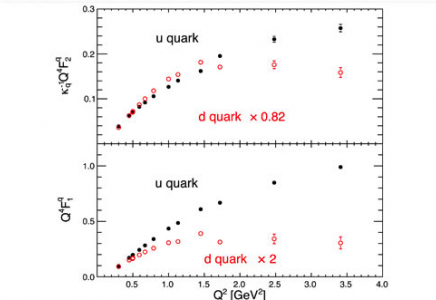Quarks Pair Up in Protons (and Neutrons)

Researchers have published intriguing new observations for how the different kinds of quarks behave inside protons and neutrons. In the proton, the down quark contributes surprisingly little to electron-proton interaction. Also, the up quark contributes much less to electron-neutron interaction than one would expect if all three quarks behaved in similar ways.
Additional Links
Ordinarily, physicists generally think of protons and neutrons as each containing three “valence” quarks, i.e. quarks that determine the charge of the proton or neutron. When they visualize the structure, they usually imagine these three quarks to be more-or-less on equal footing. Even so, puzzling data from an experiment carried out 40 years ago was thought to suggest that two of the quarks cluster together into what is called a diquark. However, there has been very little experimental evidence since then to support this idea - perhaps until now.
The new evidence was published in the journal Physical Review Letters in a paper by Gordon Cates, a physics professor at the University of Virginia; Kees de Jager, a retired Jefferson Lab staff scientist and former Jefferson Lab Experimental Hall A Leader; Seamus Reardon, now at the University of Massachusetts; and Bogdan Wojtsekhowski, a staff scientist in Jefferson Lab's Experimental Hall A. The data and insights in the paper have recently received further support and scrutiny from theory.
The result came out of data from different experiments at Jefferson Lab that used electrons to probe the structure of protons and neutrons and measure what are called electromagnetic form factors. Cates described these form factors as "the closest thing there is to a snapshot of the proton and neutron," because they indicate the location of charge, and hence the location of the quarks.
The new paper was made possible by the recent addition of high-resolution snapshots of the neutron to add to existing high-resolution snapshots of the proton.
"Now we have a game-changing approach. We are studying data from both the proton and the neutron together," Wojtsekhowski explains.
The researchers combined the data with an idea that is well accepted by physicists - the idea that a symmetry exists between protons and neutrons. Both particles are built of different combinations of up- and down-flavored valence quarks. The proton has two up quarks and one down quark, while the neutron sports the symmetrically opposite two down quarks and one up quark.
"The only difference between a proton and neutron is that you take every up
quark and turn it into a down quark, and you take every down quark and you turn it into an up quark. Otherwise, in many respects, they're the same object," Cates says.
This picture could be potentially complicated by the strange quark contribution. However, as it was observed at JLab (G0, HAPPEX) and Mainz (A4), such a contribution is consistent with zero.
Using the symmetry between protons and neutrons as well as the data, the researchers were able to tease out a picture of the individual behavior of the up quarks and down quarks. They got what can be thought of as snapshots of the up quarks and down quarks separately.
The paper findings were interpreted by theorists from Argonne National Lab and the University of Washington, who suggest a picture in which two quarks buddy up into what physicists call a diquark, leaving the last quark hanging out on its own nearby as a kind of outcast.
"In the proton, for example, you might have one of the up quarks and the only down quark combined into a diquark, with the remaining up quark off on its own," Cates says. "There are at least two recent calculations that very clearly suggest the diquark is real. If true, it would represent an exciting shift in the way we visualize the nucleon’s structure."
Even if the diquark is not the explanation of what is going on, Wojtsekhowski points out that the research still reveals key information. "We found that the doubly represented and singly represented quarks act differently,” he says.
“If you have one quark of one kind in the nucleon, it behaves one way. But if there are two quarks of the same kind, their behaviors are altered.”
Results from these precision elastic electron scattering data are interestingly consistent with the high momentum transfer inelastic electron scattering data, such as from the BONUS experiment in Hall B, where the down and up quark distributions have been shown to be different when measured in a region where nucleon binding effects are important. This may be another manifestation of a phenomenon known as quark-hadron duality, which has been the subject of multiple Jefferson Lab experiments.
The researchers say the next step is to take higher-resolution data to confirm this interpretation with the more energetic electron beams and the upgraded experimental areas of the Continuous Electron Beam Accelerator Facility that will be available following the 12 GeV Upgrade.
"It is amazing that confirmation (or dismissal) of the diquark interpretation could be obtained soon,” comments Wojtsekhowski, referring to the so-called 'Super BigBite experiments' that are approved by the Program Advisory Committee and are currently under preparation in Hall A.
- Gordon Cates, Bogdan Wojtsekhowski and Kandice Carter

